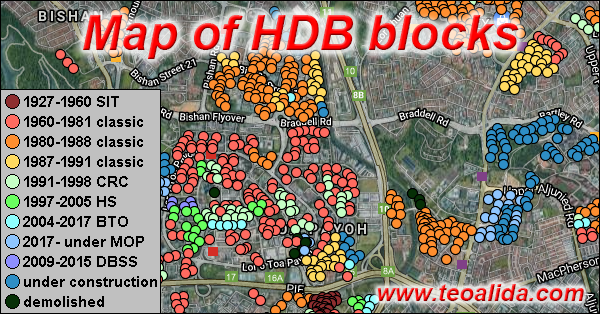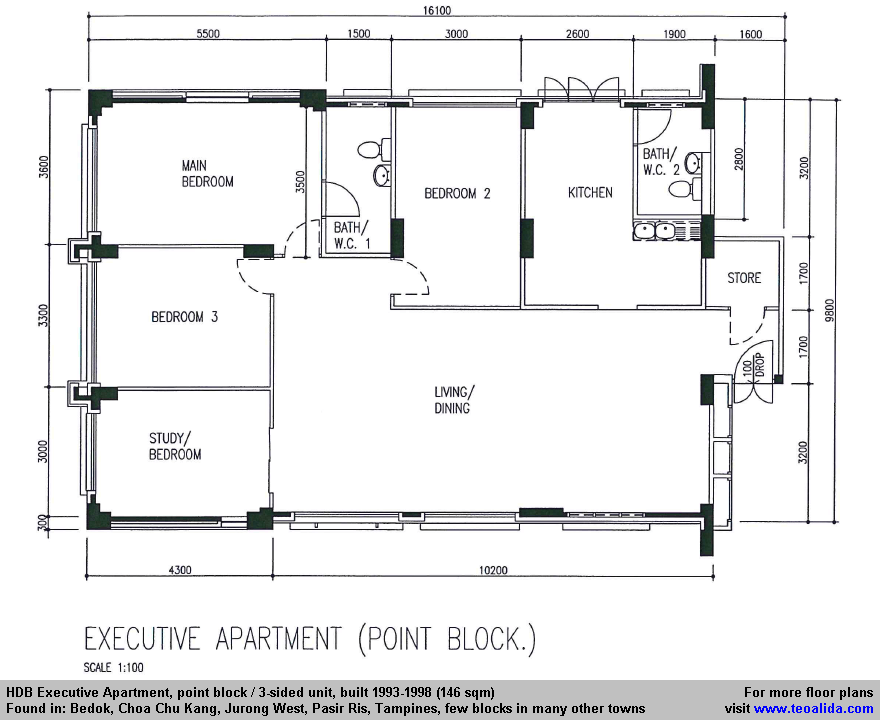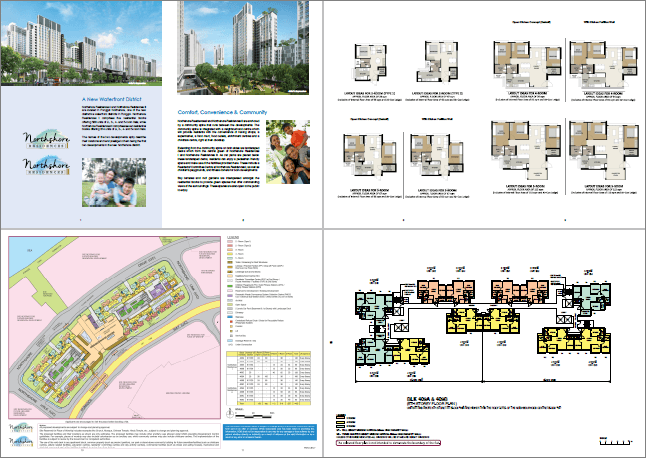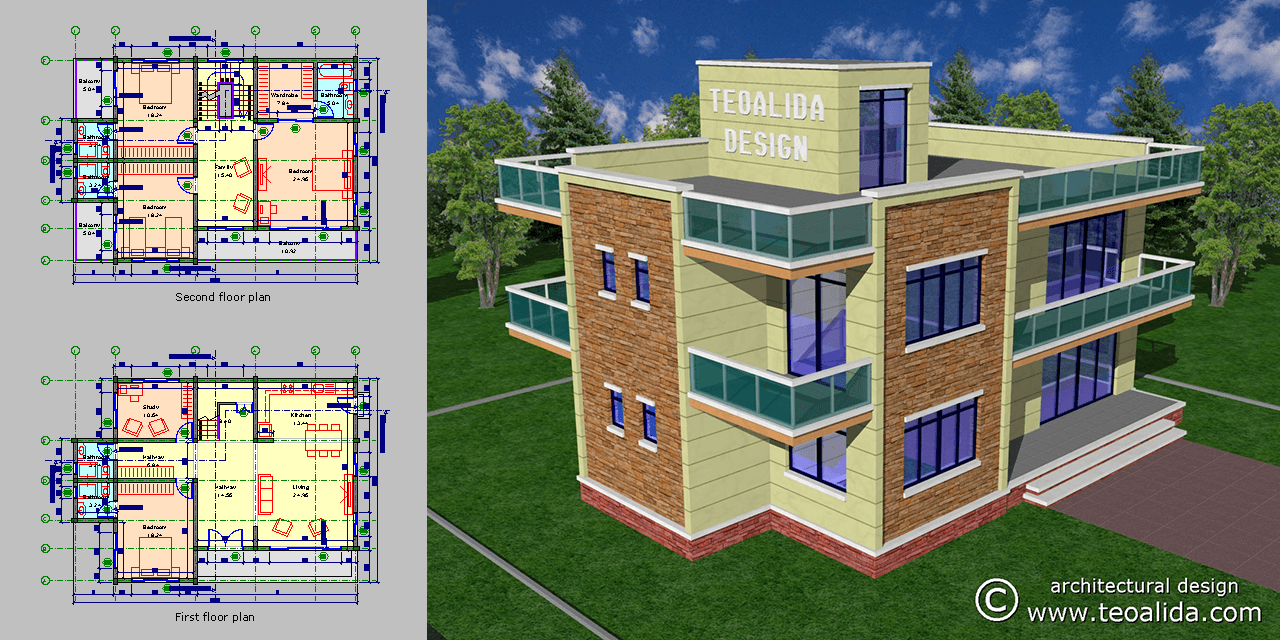I wrote half of these ideas in 2018 with intention to email them to HDB, but I was doubt that they would care 1 person sending 1 email, so I rather post on Facebook and possible other websites, to be seen by thousands people, who can comment to add their own suggestions and share it further, hoping that Ministry of National Development and HDB CEO will read and listen us.
I am Teoalida and since 2008 I research architecture and housing in various countries and design my own houses and apartment models.
I agree that Singapore have the best designed public housing in the world, but also the second most unaffordable public housing after Hong Kong (it risk to become even less affordable in the future) and I have ideas how to make housing in Singapore even better, thanks to my personal experience accumulated over last 13 years.
Note: many people from Singapore know me thanks to my website www.teoalida.com (originally made in April 2009 to showcase my architectural designs) once I published “HDB Floor Plans evolution 1930s-present” in December 2009 followed by list of BTO brochures, SERS predictions, price trends and many other articles and databases, original research that cannot be found anywhere else on the Internet.
Forecast demand and increase BTO supply to prevent rising prices
1997 Asian Crisis left HDB with about 31.000 unsold flats in the year 2000 which took few years to sell. Economy recovered in mid-2000s and HDB ramped BTO supply… but too slow, causing resales prices to double between 2007 and 2012. Instead of providing adequate supply to meet demand, HDB artificially tried to reduce demand, blaming “permanent residents” for rising resale flat prices and set a 3-year waiting period for them in August 2013: https://www.straitstimes.com/singapore/three-year-waiting-period-for-prs-to-buy-resale-flats.
This cooled down market with about 15% in 2013-2015, then instead of lifting cooling measures, HDB reduced BTO supply from 27,000 flats in 2012 to 15,000 flats in 2015, a dangerous strategy that I was expecting to cause undersupply and another price bubble during 2020s. When COVID-19 pandemic started, I was expecting prices dropping like during 2003 SARS, but contrary happened: internet connection available nowadays allowed people to work from home, and despite that pandemic caused a short-term global recession, it changed people lifestyle towards investing more in (bigger) homes, further accelerating prices growth.
Some people may comment that Registration for Flat system used until 2002 was better because everyone was getting a flat based on queue order, not based on luck like at BTO balloting. Registration for Flat had a disadvantage: you did not knew location or time you were getting the keys. BTO show you location and estimated completion date and priority schemes allow higher chances at balloting to people needing a home urgently, so it is better… was better IF flat supply matched demand, otherwise BTO is a lottery rather than a reliable housing scheme.
Among people visiting my website and talking with me, some informed me that applied for BTO 5+ times without success, then bought a resale flat, or went directly to resale market (despite of being eligible for BTO) to avoid wasting time in BTO lottery where only 1 of 4.4 first timers and only 1 of 18 second timers win a prize with 4 years delivery time (this is average application rate for BTO launches of Feb 2019 to May 2021).
South Korea also had a problem with undersupply and very high apartment prices during 1980s. They managed to keep the prices stable from 1990 to today by building 116% compared with demand. Also government regulate maximum prices by apartment size for private developers. Source: https://www.adb.org/sites/default/files/publication/183281/adbi-wp570.pdf
My suggestion: HDB should forecast demand for flats by looking at immigration rate, conversion to citizenship rate and marriage rate, instead of number of applicants for past BTOs, and should build a bit higher than demand until the application ratio for each BTO drops to 1:1. Since 2018 HDB launched few BTO with shorter waiting time (2.5 years) because construction started before sale launch, but in my opinion at least half, if not all BTO must have construction started in advance so the waiting time will be 2 years, to counter rising resale prices by turning resale buyers towards BTO (how many people like waiting 4-year for BTO to be built?). It is inevitable that some flats will remain unsold, they can be always re-offered for sale Sale of Balance Flats during construction or after completion, to people who are in immediate need of a flat.
Anyone know where I can find median wage or median household income for last 30 years? I want to compare with BTO and median resale prices.
How to make better town planning
My favorite towns are Punggol and Fernvale neighborhood of Sengkang, having parallel roads at 300-500 meters apart, forming clusters of 2000-3000 flats, 3-4-5 BTOs sharing a common green. But I see roads unnecessarily wide. I also like Woodlands with 4-lane roads at 600-800 meters apart and inside them are just minor 2-lane roads. I wish to see bigger BTO projects with 1000-2000 flats or higher. Anchorvale Gardens (blk 313-318, pre-BTO project) is one of my favorite projects, 22 nearly parallel blocks with 1896 flats on 11 hectare land (about 320 x 350 m), density: 172 units/ha. But in the recent years, new towns were designed with too many wide roads, oversplitting land into smaller parcels, wide roads requiring bigger buffers. For example:
Between Yishun Ring Road, Avenue 11, 6, 1, Street 41, there is 26 hectare land, it had 8 blocks (968 flats) built in 1987 in middle of an empty field that was developed 20 years later, with 5 BTO projects (4420 flats) and 1 school, density: 207 units/ha.
Next to it, between Yishun Avenue 6, 8, 1, there was a 30 hectare land, but been subdivided into 4 parcels separated by 3 four-lane streets (Yishun St 42, 43, 44) and been filled by 6 BTO projects (total 5123 flats) and 1 school, density: 170 units/ha.
By building additional 3 unnecessarily wide streets, HDB wasted about 15% of land that could held additional 800-1000 flats. The scope was to avoid carpark access from category 2 roads like Avenue 8 and 1, but in my opinion instead of 3 four-lane streets, it was enough 1 two-lane street with a dead end like Sumang Lane that serve few BTO in Punggol.
Tampines Street 86 is another unnecessary four-lane road that split a 280-meter wide parcel into two 125-meter wide parcels, wasting 30-meter strip of land.
Same problem happen in Sembawang 1xx neighborhood, divided by too many roads close apart, just 180 meters between Canberra Link and Canberra Crescent, or between Yishun Avenue 8 and Canberra Street, forming clusters of max 1000 flats.
When Tengah New Town was announced in 2016 it made me crying “When completed, Tengah is estimated to provide about 42,000 new homes. Of these, about 30,000 units will be for public housing and 12,000 units will be for private housing.” this means one year and half of BTO launches, on 7 sqm land.
My suggestion: HDB and URA should design future new towns with 4-lane roads spaced 600 meters apart and 2-lane roads inside like Woodlands, and cluster several BTO projects around a common green like in Punggol.
How to make better block planning
Since 1960s to 1990s HDB designed estates based on density of 200 units/hectare, most blocks having common corridor on one side and cross-ventilated flats. To accommodate larger flats, distance between block facades been reduced from 30 m in 1970s to 24 m in 1980s and 18.3 m in 1990s. After 2000 most HDB blocks have a central corridor with flats on both sides, allowing higher density without reducing distance between facades (actually blocks are now more spaced apart because they reach maximum plot ratio, I wish URA to increase plot ratios for these parcels that allow 40+ storey). But I saw some bad designs, for example SkyResidence @ Dawson https://www.teoalida.com/singapore/hdb-brochures/SERS/SERS%20Dawson%20C3.pdf blocks measure about 40 x 20 meters and have only 4 units per floor, lift lobby being exposed on both sides where they could fit 2 more units (for comparison Pinnacle@Duxton blocks measure 40×24 measure at 6 units per floor).
Residential blocks can go taller, but carparks how tall they can go? It is inconvenient to drive a car in spiral more than 5 floors. Because of column pattern of residential blocks, is not ideal to have carpark right underneath, but carpark can be in the space between blocks. HDB has been building such basement carparks with landscape deck since 1990s (Choa Chu Kang blk 631-637 and 638-643) and I like them because you can go with lift directly to carpark. Why today most BTO still have carpark buildings up to 8 floors and separated from residential buildings?
Increase HDB flat sizes
The size of HDB flats had an upward trend from 1960s to 1990s followed by a downward trend that continue today.
4-room flats completed in 1982-1990 were 104 sqm, in 1990-1994 107 sqm, since 1994 they were downsized to 100 sqm, since 1997 household shelter was added eating 5 sqm of space, since 1999 they were further downsized to 90 sqm. Consequently, living room and bedrooms lost about 20% of space, even more loss in case of kitchen. I agree that we do not need huge kitchens, but bedroom size is an issue. During 1980s, master bedroom in 4/5-room flats was around 14 sqm and common bedrooms 11 sqm. Today master bedroom is about 10 sqm and common bedrooms 9 sqm. Beside downsize by flat type, the flat types supplied have changed.
HDB CEO, Dr Cheong Koon Hean, said that smaller flats do not mean lower quality of living, referring that family size decreased and square meter per person increased for 5-room flats, but exactly the table provided by her, shows that nationwide sqm per person is DECREASING, because in 1990s 3.9 people were living in 4-Room to Executive flats (100-140 sqm), while today 3.4 people are crowding 2-Room and 5-Room (45-110 sqm).
I understand that we need to find a compromise for the land-scarce Singapore, but today flats are just… too small for the needs of a developed country. We are not in the third-world Philippines!
My suggestion: HDB must build flats sized like this: 2-Room 40/50 sqm, 3-Room 75 sqm, 4-Room 100 sqm, 5-Room 120 sqm, 3gen 130 sqm. Supply of 5-Room flats must be increased to keep average flat size around 100 sqm. Some people would suggest reintroduction of Executive at the size they were in early 2000s, but I think that they will be purchased by families able to afford more space than they need rather than big families, so 3gen flats restricted to 2+1 applicants are better scheme than Executive.
Optimize HDB flat layout
HDB claim that today flats are designed more space-efficient, but many people claim that they are less efficient because of household shelter and corridor to bedrooms. What actually did HDB optimized is to make each room at right size, for example most BTO kitchens are 2.2-2.4m wide to allow 60cm cabinets on both sides and leave 120 cm open space, compared with older designs which had much bigger kitchens, a space wasted that could be allocated to other rooms instead.
Nowadays more and more people prefer open-concept kitchens which made HDB to offer option to purchase BTO without kitchen/living partition wall except 2-room flats where kitchen size average 6 sqm like for 3-room and 4-room flats, but position of kitchen to have window facing in the same direction with living and bedroom, and the hallway between kitchen and household shelter waste space, and if total flat size wasn’t already too small, “livable area” (living room and bedroom) is just half of it.
I have seen many flat owners hacking bedrooms, to expand living room which does not fit a couch, TV and dining table without blocking main door or passage to bedrooms, or to expand master bedroom which in some BTO is small like a common bedroom and does not fit a double bed, wardrobe and desk with computer, so they turn a common bedroom into a wardrobe or computer/work room. This leave less rooms for kids, so families are discouraged to make more than 1 baby, which contradict MND policy to make more babies. I do not complain about size of common bedrooms, today kids tend to play more on iPhone than with bulky toys.
My suggestion: design flats better living room shape and master bedroom about 30-40% bigger than common bedrooms. For 2-room flats (at least the smaller type) make open-concept kitchens on a wall of living room.
Notes: in Eastern Europe 50-60% of flats built by former communism governments are 1-room and 2-room flats (you enter in a hallway with doors to living room, bedrooms and kitchen, so living room can be used for sleeping too), while post-communism developers also build 2/3-room flats because they are on demand, communism shaped people lifestyle to live in small spaces, consequently fertility rates are among lowest in the world, under 1.5 children per woman according https://en.wikipedia.org/wiki/List_of_sovereign_states_and_dependencies_by_total_fertility_rate.
You can see my architectural designs in https://www.teoalida.com/design/apartmentplans/ (some being improved HDB designs, some are inspired from Hong Kong, Europe and Latin America, some are my original concepts). Some of my designs does not follow Singapore building codes, but allow anyone to compare various flat layouts and give ideas to HDB architects how to design better flats.
Regulate flat sizes in condominiums
While HDB flat sizes remained unchanged from 2000 onward, the profit-hungry private developers downsized flats further in condos, executive condominiums and DBSS flats. URA decided in 2012 to limit maximum number of units in new condos by requiring developers to provide have average flat size of at least 70 sqm, raised to 85 sqm in 2018 (source: https://www.ura.gov.sg/Corporate/Guidelines/Circulars/dc18-06). This is good, but not sufficient.
I think that was a BAD idea to cap EC flat size to 160 sqm, now the profit-hungry developers build smaller rooms to increase number of flats and reduce building costs per flat, but actually raising price per square meter. Recent EC include 5-bedroom flats, but each bedroom is about 7-8 sqm (2.5 x 3m). Who does need so many rooms with such little space? No wonder why there are so many unsold EC nowadays and people battle for BTO.
I noticed that some private condos reduced bedrooms to minimum size that fit a bed (2×2 meters) example https://www.propertyguru.com.sg/project/treescape-21500#floorplans (1-bedroom+study 40 sqm , 2-bedroom 49 sqm, 3-bedroom 56-65 sqm, 4-bedroom 84 sqm) thus Singapore risk to become the second Hong Kong!
My suggestion: URA should regulate minimum size for each apartment type: 2-room 40 sqm, 3-room 60 sqm, 4-room 80 sqm, etc, without balcony and A/C ledge, otherwise developers will build oversized balconies to keep apartments small since only internal area is computed in max allowed GFA. Other countries like Ireland regulate minimum size to 1-bedroom 45 sqm, 2-bedroom 73 sqm, 3-bedroom 90 sqm (source: https://www.rte.ie/news/business/2015/1222/755594-apartment-sizes/). Would be good also minimum area and width of each room. Malaysia building code set minimum size 11 sqm for first bedroom, 9.3 sqm for second, 6.5 sqm for third. Most countries have similar rules.
The day when Singapore will run out of land
According HDB Annual Report 2021 (https://www.hdb.gov.sg/about-us/news-and-publications/annual-reports), HDB towns house 80% of population on 18837 ha of land (25% of total land of Singapore) of which 7406 ha for residential purposes, now don’t say that Singapore can hold 4 times more HDBs, because we need also land for industry and leisure. I see industrial areas being redeveloped multi-storey factories, and very little land been developed as landed housing after 2010s compared with previous decades, but what we should do with existing landed houses? They represent only 5% of housing units but use almost as much land like HDB towns. And the good-class bungalows. I love landed houses too and I would be sad to see they gone, but in land-scarce Singapore we must get rid of them.
There are many landed housing estates with old and dilapidated houses (best example: MacPherson estate, around Jalan Mulia) that are being demolished and rebuilt in modern style one by one. But imagine if Serangoon Gardens estate would have been demolished en-bloc for HDB development? The 2 square km area could held 30,000-40,000 HDB flats! However I don’t see feasible, each land owner must be compensated with a huge $ and some will refuse to sell.
My personal forecast is that current HDB towns will get full by 2025, and new towns must be started, possible Simpang, Paya Lebar and Western Water Catchment, and in late 2030s VERS will start to redevelop all old HDBs (expect less benefits in VERS than SERS, details are unknown yet), but if population reach 7 milion, Singapore will run out of land for new developments, HDB flats will undergo a new downsize to Hong Kong size. Do we need to restrict immigration to make population dropping? How do you imagine Singapore in the year 2050?




Hello Teoalida I want to send in A request to the IP intellectural Property Director Michelle Lee providing you here from her tell her what you can do and walter’s been in touch.USPTO.GOV for office of solicitation solicitor Thomas Krause leaveing you with A message I need 80 apartments the office may have A statement in construction. text back 908-422-4901
Setting up a town is not easy either. There are parts of land that need to be recovered, so there should be adequate compensation.
It’s not simple to establish a town either. There is land that must be recovered, and those responsible must be fairly compensated for their efforts.
I agree that Singapore has the best-designed public housing in the world, but it’s important to make sure that it remains affordable for all Singaporeans.
Why So An*ry
Hi, I fully agree with your suggestions, insights and analysis. There was a recent episode of Talking Point that touches on the various points you brought out, CNA Insider should have invited you also to that episode “Talking Point 2023/2024 – Will My HDB Flat Be More Affordable? 27 Aug 2023 11:00pm”. The HDB director gave the standard excuses for why HDB flats are smaller now (because family unit size is smaller). One of the guest, Nicholas Mak, then brilliantly counter back – be it a family of 1 person or 6 people, each family will have “static” spaces for their fridge, dinning table, that they cannot do without, thus building smaller due to smaller family size is not a good argument at all. Personally I feel HDB designers are really out-of-touch. Perhaps a good number of them lives in old large size HDB, or private bungalows, so they don’t really care about new BTO livable spaces. Or some of them are trying to score-point with the HDB CEO – see how my design reduces spaces, and increases per sqm profits for HDB, give me high bonus this year please. This is the same as your point about livable space. HDB can easily design flats 5 or 10 sqm bigger, larger spaces also may help in mental health, but the HDB of now, seems to care less about citizen’s welfare, mental health, comfort. And the excuse of “HDB is making a loss” fools no one, HDB as public housing, should not include land cost in its price, because the land is returned back to the state, we are only renting for 99 years. I can bring up many more points, but I doubt HDB will ever do anything about these issue. By the way, thanks for running this website where I can find so much info about HDB, and also find the hard-to-find floor plans.